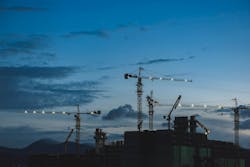Strict Seismic Building Codes Credited with Minimizing Damage in Alaskan Earthquake
There were no reports of major damage or collapsed buildings following the magnitude 7.0 earthquake that shook Anchorage, Alaska. The tremor cracked roads and collapsed some highway ramps, but other structures endured the quake fairly well. Alaska’s stringent seismic code gets the credit for that.
Along with California, Alaska has the highest seismic standards in the nation. The state implemented the strict code after it experienced a devastating 1964 earthquake (a 9.2 magnitude), the most powerful on record in the U.S.
The code mandates that structural connections, such as beams and columns, be reinforced to resist damage from shaking.
Urban Flooding Causing Economic Loss, Social Disruption, and Housing Inequality
Several factors are contributing to increased vulnerability to flooding in urban areas, according to The Growing Threat of Urban Flooding: A National Challenge, a new report by the University of Maryland and Texas A&M University. As the nation experiences more intense rainfall events, many cities have inadequate infrastructure to cope, the report says. Adding to the problem has been rapid suburban and urban land development that has increased the amount of stormwater runoff.
With multiple government agencies at all levels having some responsibility for these issues, there is lack of collaboration and coordination needed to address technical and political challenges. For example, information on how property owners can reduce their flood risk is not accessible or well-articulated, the report says.
In addition, a significant number of areas vulnerable to urban flooding are not identified by FEMA National Flood Insurance Program maps. The reports’ authors made a series of recommendations including that Congress assign one federal agency to provide interim oversight of federal support of urban flood mitigation activities.
Emissions for Buildings and Construction Have Peaked, UN Says
Greenhouse gas emissions appear to have leveled off, according to findings from the United Nations Environment organization. Though emissions from the sector were flat from 2015-2017, they still represent about a third of the global emissions that cause climate change. Nevertheless, the progress being made in designing and constructing greener buildings has helped to hold the line on emissions.
The positive finding was a rare bright spot amid warnings from a UN meeting in Katowice, Poland that not enough is being done to stop the planet from heating up. The meeting is aimed at meeting a deadline to agree on rules on how to enforce the Paris Climate Agreement.
Global carbon emissions are projected to rise nearly 3% this year, scientists said. To encourage energy-efficient buildings, nations could push for better insulation and windows by revamping building codes and setting up energy certification schemes, according to a UN report. Actions to lower emissions from common building materials like cement and steel, whose manufacturing generates large amounts of carbon, would also be productive, the report said.
Calif. House Built for Wildfire Resiliency
A single-story stucco-and-glass house in Ramona, Calif., was constructed to be highly resistant to wildfires. “Casa Aguila” was built with fire- and power outage-resistant features such as stucco and concrete walls, stone and tile ground covering, metal roofing and posts, high-impact windows, energy-efficient construction, on-site wind and solar power generation and storage, and on-site water collection and recycling systems.
The energy- efficient structure was also certified to the U.S. Department of Energy’s Zero Energy Ready Home (ZERH) criteria. A fire had claimed the previous home on the property, and the owners were determined to rebuild with fire-resistant features and water and energy self-sufficiency.
More Fire- Resistant Homes Could be Built Without Increasing Construction Costs
Homes in areas vulnerable to wildfires could be built to better withstand blazes with no increase in construction cost, according to a new report released by the Insurance Institute for Business & Home Safety. The report compared a standard design on a typical three-bedroom, 2,500-square-foot, single-story home constructed last year in Park County, Montana, to one conforming to the International Wildland-Urban Interface Code.
Using a fire-resistant roof, vents, and gutters on the home would increase material costs by $6,000, or about 27%. Fire-resistant doors and windows would add to the expenses by another $5,000. But the added costs would be offset by the use of fiber-cement siding— a fire-resistant material that is less than half the price of more commonly used cedar-plank siding. Overall, the cost of the fire-resistant home would be 2% less than the standard design.
